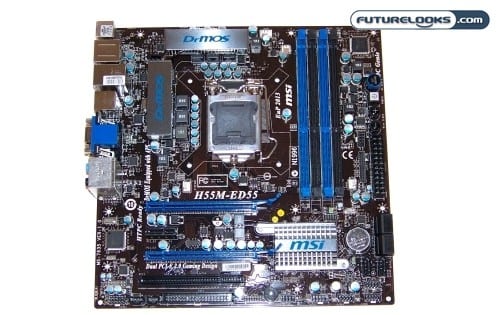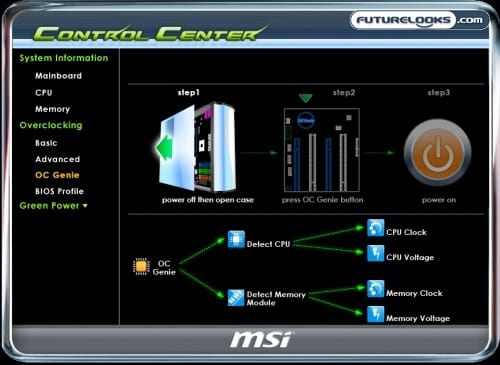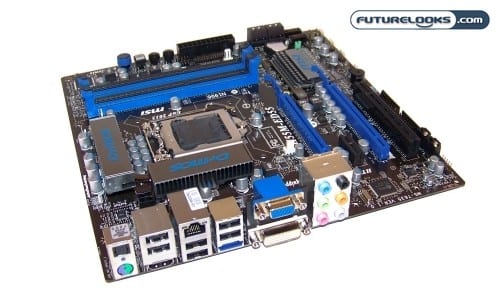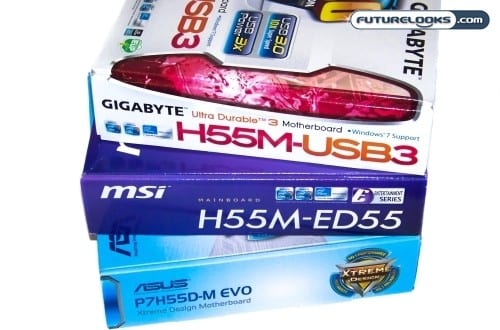MSI H55M-ED55 Features

Changing gears a bit, the MSI H55M-ED55 is step in the other direction in terms of overclocking, but not in expansion. For instance, the board offers OC Genie but does not offer USB 3.0 or SATA3 like the other two. OC Genie is perhaps the easiest built-in real-time overclocking feature any board maker currently offers. The novice user need only reference the manual, or use their gut to figure this one out. After engaging the Genie, one simply has to push the plus button to start increasing the CPU’s Bus Clock, thus overclocking the CPU. If the system seems on the verge of instability, simply press the minus key till satisfied using your favourite stability test as a check in between.

Dr.MOS, essentially MSI’s server grade platform power management circuitry, is designed to offer clean, reliable power to the CPU at all times especially when overclocked. When coupled with MSI Control Center, users can enjoy three performance options, GreenPower for efficiency which is especially supported by the Active Phase Switching feature, XpressCool to control system cooling noise, and RapidBoost for the strongest performance one might demand from the platform.
If you happen to do something naughty to your system and the board’s BIOS fails to load properly, M-Flash can recover your motherboard. Using a USB flash drive, users can recover the system with the BIOS file of choice. You can store one or more files on the drive if needed as well. This is similar to, but not as automatic as GIGABYTE’s Dual BIOS which lives on the board and simply kicks in when there is a problem with BIOS loading.
Of the three platforms, this is the only LGA1156 m-ATX platform to support dual CrossfireX graphics cards. Of course this won’t satisfy SLI fans, but ATI’s current generation 40nm GPU is nothing to scoff at. We’ve seen the HD 5870 in action first hand, so two would rock your noggin on this little board. Definitely engineered as a performer here.
MSI H55M-ED55 Closer Look
The ED55 follows the path of the enthusiast. Here we have a m-ATX board that’s dark, short, and handsome. The blue and black theme contrast well with the DrMOS heat sinks around the CPU socket. MSI engineers apparently did a little note taking since there are horizontal SATA ports obviously intended to offset any issues with either of the PCI Express slots. The two other SATA ports will conflict with the second PCIe slot when running two video cards. Thankfully, the horizontals will probably be enough for an avid gamer or home user. It would have been nice if all six were set to the side.

The board unfortunately also offers an IDE port at the bottom. While we would like to see this omitted, it’s at least located at the bottom probably due to its low priority. Jump in the SATAII side of the pool, it feels great.
Next to the 24-pin main power port, we have the ever so simple, yet powerful, OC Genie, adjustment buttons, and power button. While the power button is useful welcomed extra, it’s the OC Genie that deserves the applause. They’re located in a good spot where gurus can get their clock on easily.
Test System Setup and Test Procedures
To answer a few questions, no conflicts or notable issues were encountered during installation. In fact, each platform worked very well right down to working with each BIOS. Of the three BIOS, the ASUS is the most detailed with far more settings for extreme tweaking. The GIGABYTE offers the most basic of set up options, but was also the quickest to set up. The MSI is some where in between the two offerings with enough settings to be dangerous, but not enough to overwhelm.
Our Test Systems were outfitted with the same parts list which include:
- Processor: Intel Core i5-661 Clarkdale
- Motherboard 1: GIGABYTE GA-H55M-USB3 Motherboard (BIOS F9)
- Motherboard 2: ASUS P7H55D-M EVO Motherboard (BIOS 0903)
- Motherboard 3: MSI H55M-ED55 Motherboard (BIOS 1.4)
- Memory: Corsair Dominator 4GB 1600MHz DDR3 Memory
- Hard Drive: Kingston 128GB SSDNow
- Power Supply: Antec CP-850 Watt Power Supply
- CPU Cooler: Thermalright MUX-120
- Operating System: Windows 7 Pro
USB 3.0 tests for the two capable boards were carried out using the Rosewill RX358-U3B USB 3.0 enclosure which was supplied by Rosewill for our USB 3.0 testing. with a Western Digital Black 2TB SATAII Hard Drive inside, the enclosure offers active cooling and USB 3.0 performance that is powered by an ASMedia chip, which, coincidentally, is a sub brand of ASUS. This is the same enclosure we used for the AMD 890GX Round Up earlier in the year and we’ll be eying it for any favoritism towards the ASUS board.
Since we just love our mean, little Core i5-661 Processor, we’ll be using it throughout the testing as listed. It’s a good budget oriented CPU for these particular motherboards and loves a little overclocking, if there’s any to be had. But, they’ll do just as well with a Core i7 860 if you are looking for more top end performance on this all around platform.

